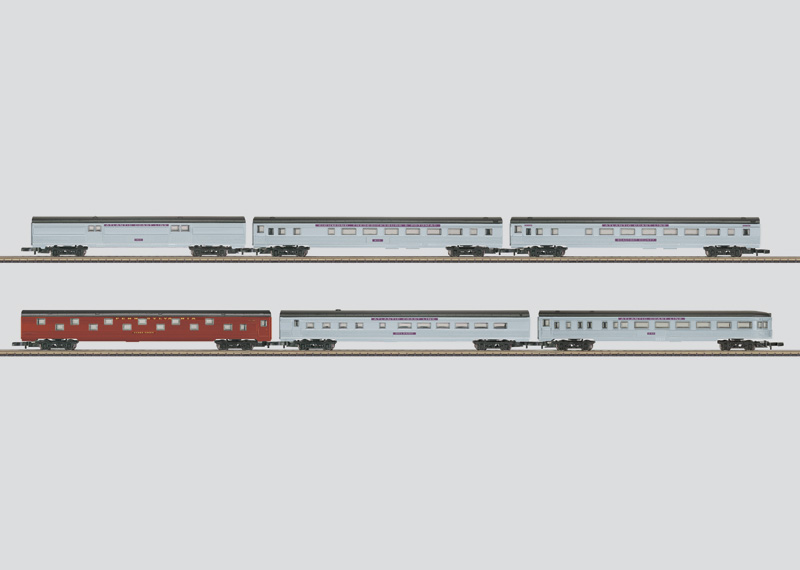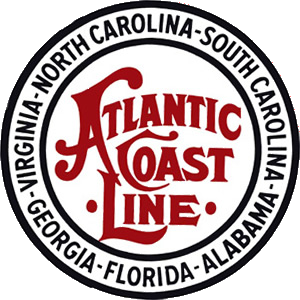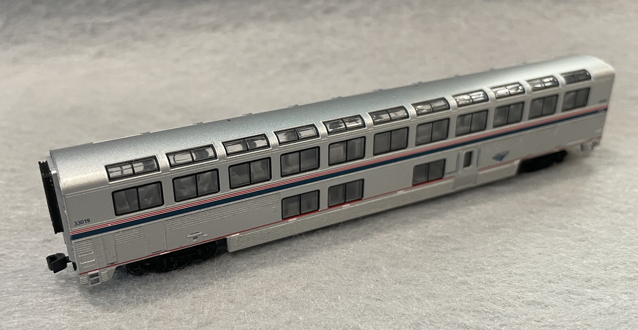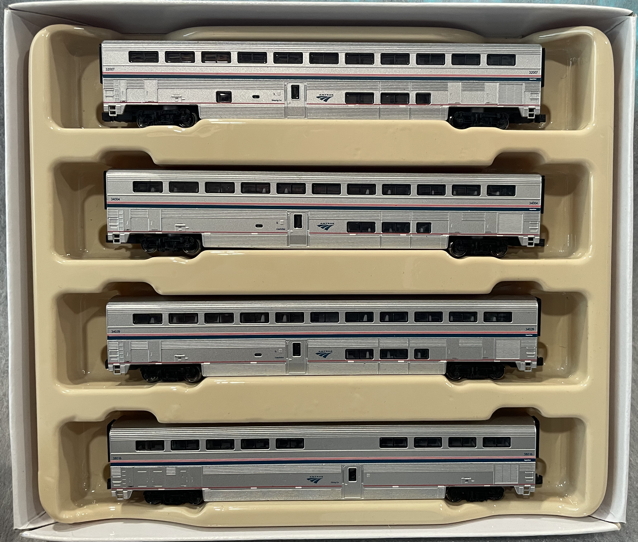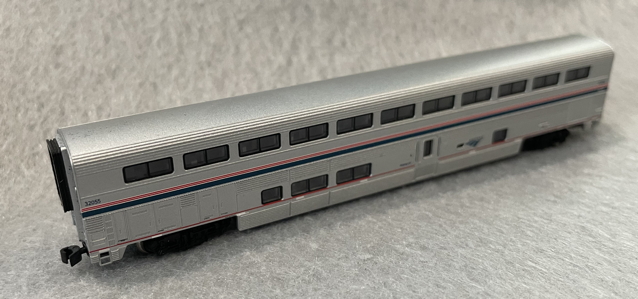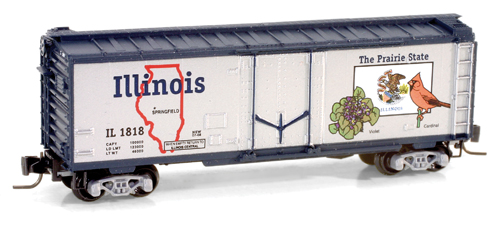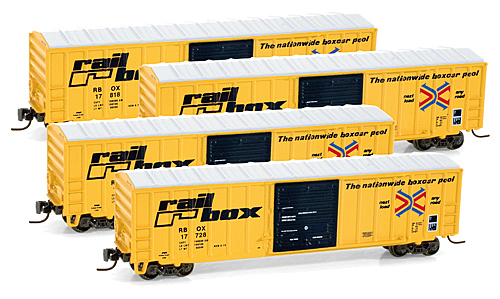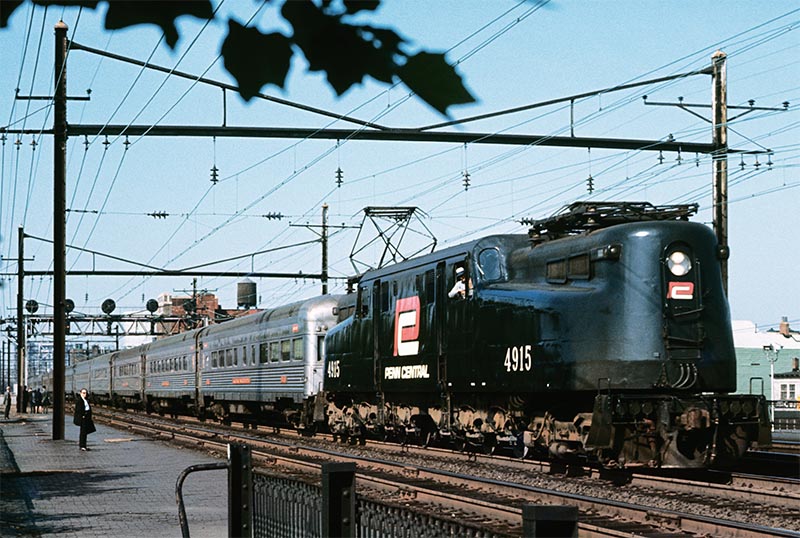Specific Item Information: Gauge Z - Article No. 87846
Streamliner Passenger Car Set.
Prototype: 6 different streamliner cars painted and lettered for different American railroads. 1 Atlantic Coast Line baggage car. 1 Richmond, Fredericksburg & Potomac passenger coach. 1 Atlantic Coast Line dining car. 1 Atlantic Coast Line sleeping car. 1 Pennsylvania duplex roomette car. 1 Atlantic Coast Line chair observation car.
Model: All cars in a special version. Not available separately. Total length 683 mm / 26-7/8*.
Prototype History: Due to the advantages of diesel locomotives, railroads in North America had retired 90% of their steam locomotives by the mid-1950. Also, major cities and their rail yards became unhappy neighbors in post-war America. People were no longer content to endure the large amounts of soot and smoke that coal burning steam engines produced. Early diesels, while dirty by today's standards, were a gigantic improvement in air pollution over steam.
Passenger consists were considered the most 'sexy' of any railroads operations, and hence usually got the newest flashiest equipment. A major exception, of course, was Amtrak, which had no competition and a huge inventory of cast-off locomotives and rolling stock acquired during its formation. Hence, rail service in the 1960s and 1970s was a hodgepodge of the newest, best-looking locomotives and railcars as well as a showcase for older makeshift equipment.
Passenger consists were considered the most 'sexy' of any railroads operations, and hence usually got the newest flashiest equipment. A major exception, of course, was Amtrak, which had no competition and a huge inventory of cast-off locomotives and rolling stock acquired during its formation. Hence, rail service in the 1960s and 1970s was a hodgepodge of the newest, best-looking locomotives and railcars as well as a showcase for older makeshift equipment.
Road Name History: ACL’s roots go back to the Petersburg Railroad in 1830. By the 1870s, their successors and some affiliated lines began using Atlantic Coast Line as a nickname and through a number of consolidations Atlantic Coast Line became the official name by 1900.
Atlantic Coast Line funneled traffic from northern Virginia (and its connections to the northeastern trunk lines via the RF&P) down through the Carolinas, Georgia and into Florida as far as Naples on the Gulf Coast. Acquisitions after the war added routes from Columbia and Spartanburg, South Carolina to the coast and lines linking Atlanta, Birmingham and Montgomery to southern Georgia and Florida.
At that point, the Atlantic Coast Line boasted 5,743 miles of railroad, 629 locomotives, 361 passenger cars, and 31,284 freight cars. To put that into perspective for you western guys, that's four times the size of Western Pacific.
ACL was the premier route for New York to Florida passenger traffic. The ACL's "Champion" left New York on the Pennsy, was handed off to the RF&P from Washington to Richmond, ran on the ACL to Jacksonville, FL and was then handed off to Florida East Coast for the ride to Miami. The "West Coast Champion" skipped the FEC as ACL went all the way to Tampa on Florida's Gulf Coast on its own rails. ACL also forwarded some Chicago to Florida trains via connections. Much of the system was relatively flat, allowing ACL to use 4-6-2’s in fast freight service (one of the few railroads to do this.)
ACL is best known for its purple and silver diesels. This scheme was used on freight, passenger, and switcher power until 1957. By that time, it became clear that these colors were difficult to maintain, so the ACL switched to racing stallion black with yellow “tack.” The Atlantic Coast Line merged with the Seaboard Air Line Railroad in 1967 to form the Seaboard Coast Line.
At that point, the Atlantic Coast Line boasted 5,743 miles of railroad, 629 locomotives, 361 passenger cars, and 31,284 freight cars. To put that into perspective for you western guys, that's four times the size of Western Pacific.
ACL was the premier route for New York to Florida passenger traffic. The ACL's "Champion" left New York on the Pennsy, was handed off to the RF&P from Washington to Richmond, ran on the ACL to Jacksonville, FL and was then handed off to Florida East Coast for the ride to Miami. The "West Coast Champion" skipped the FEC as ACL went all the way to Tampa on Florida's Gulf Coast on its own rails. ACL also forwarded some Chicago to Florida trains via connections. Much of the system was relatively flat, allowing ACL to use 4-6-2’s in fast freight service (one of the few railroads to do this.)
ACL is best known for its purple and silver diesels. This scheme was used on freight, passenger, and switcher power until 1957. By that time, it became clear that these colors were difficult to maintain, so the ACL switched to racing stallion black with yellow “tack.” The Atlantic Coast Line merged with the Seaboard Air Line Railroad in 1967 to form the Seaboard Coast Line.
Brand/Importer Information: Gebr. Märklin & Cie. GmbH or Märklin (MÄRKLIN or MAERKLIN in capital letters) is a German toy company. The company was founded in 1859 and is based at Göppingen in Baden-Württemberg. Although it originally specialized in doll house accessories, today it is best known for model railways and technical toys. In some parts of Germany and in Sweden, the company's name is almost synonymous with model railroads.
Märklin introduced Z Scale in 1972. Connoisseurs appreciate Märklin Z as much as the most inveterate modeler: The charm of these finely constructed gems is best seen in the smallest of space. Because, this scale with all kinds of precision translated into 1:220 scale awaits you with almost unlimited operating enjoyment. It doesn't get any better.
Märklin introduced Z Scale in 1972. Connoisseurs appreciate Märklin Z as much as the most inveterate modeler: The charm of these finely constructed gems is best seen in the smallest of space. Because, this scale with all kinds of precision translated into 1:220 scale awaits you with almost unlimited operating enjoyment. It doesn't get any better.
Item created by: gbhoffman on 2024-01-08 18:48:34. Last edited by gbhoffman on 2024-01-08 18:50:28
If you see errors or missing data in this entry, please feel free to log in and edit it. Anyone with a Gmail account can log in instantly.
If you see errors or missing data in this entry, please feel free to log in and edit it. Anyone with a Gmail account can log in instantly.


